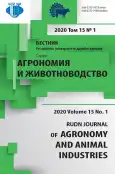Effect of humic acid and naphthalene acetic acid on vegetative growth and fruit quality of tomato plants Lycopersicon esculentum
- Authors: Suliman A.A.1,2, Abramov A.G.2, Shalamova A.A.2, Badran A.M.3,4
-
Affiliations:
- National Research Centre
- Kazan State Agrarian University
- Desert Research Center
- Peoples’ Friendship University of Russia
- Issue: Vol 15, No 1 (2020)
- Pages: 30-39
- Section: Crop production
- URL: https://journal-vniispk.ru/2312-797X/article/view/316881
- DOI: https://doi.org/10.22363/2312-797X-2020-15-1-30-39
- ID: 316881
Cite item
Full Text
Abstract
About the authors
Ahmad Ali Suliman
National Research Centre; Kazan State Agrarian University
Email: a_elsagheer2006@yahoo.com
PhD student, National Research Centre Giza, Egypt; Kazan, Republic of Tatarstan, Russian Federation
Alexandr Gennadevich Abramov
Kazan State Agrarian University
Email: gal4959@yandex.ru
Candidate of Agricultural Sciences, Associate Professor, Department of plant and vegetable production Kazan, Republic of Tatarstan, Russian Federation
Anna Alekseevna Shalamova
Kazan State Agrarian University
Email: a6685025a@yandex.ru
Candidate of Agricultural Sciences, senior researcher, Department of plant and vegetable production Kazan, Republic of Tatarstan, Russian Federation
Antar Mahmoud Badran
Desert Research Center; Peoples’ Friendship University of Russia
Email: dr_antar_mahmoud@yahoo.com
PhD student, Agroengineering Department, Agrarian and Technological Institute Cairo, Egypt; Moscow, Russian Federation
References
- Kaloo. Tomato: Lycopesicon esculentum Miller. New Delhi: Allied publishers private. ltd; 1986.
- Singh SK, Nidhika T, Yamini S. Plant growth regulators in fruit and vegetable crops. International Journal of Agricultural Sciences. 2013; 9(1):433-437.
- Kader AA. Flavor quality of fruits and vegetables. Journal of the Science of Food and Agriculture. 2008; 88(11):1863-1868. doi: 10.1002/jsfa.3293
- Santner A, Calderon-Villalobos L, Estelle M. Plant hormones are versatile chemical regulators of plant growth. Nat Chem Biol. 2009; 5:301-307. doi: 10.1038/nchembio.165
- FAO 2017. Available from: http://www.fao.org/faostat/en/#data/QC14/07/2017.
- Taylor IB. Biosystematics of the tomato. In: Atherton JG, Rudich J. (eds.) The tomato crop: A scientific basis for improvement. New York: Chapman and Hill; 1986. p. 1-34.
- Bhowmik D, Kumar KS, Paswan S, Srivastava S. Tomato-A Natural Medicine and Its Health Benefits. Journal of Pharmacognosy and Phytochemistry. 2012; 1(1): 33-43.
- AOAC. Official methods of analysis of the Association of Official Analytical Chemists. 15th ed. Washington: Association of Official Analytical Chemists; 1990.
- AOAC. Official methods of analysis of AOAC International. 18th ed. Gaithersburg: AOAC International; 2006.
- Mohammed M, Wilson LA, Gomes PL. Postharvest sensory and physiochemical attributes of processing and non-processing tomato cultivars. J Food Qual. 1999; 22(2):167-182. doi: 10.1111/j.1745-4557.1999. tb00549.x
- Valdrighi MM, Pera A, Agnolucci M, Frassinetti S, Lunardi D, Vallini G. Effects of compost-derived humic acids on vegetable biomass production and microbial growth within a plant (Cichorium intybus)-soil system: a comparative study. Agric Eco and Envir. 1996; 58(2-3):133-144. doi: 10.1016/0167-8809(96)01031-6
- Chen Y, Aviad T. Effects of humic substances on plant growth. In: MacCarthy P, Clapp CE, Malcolm RL, Bloom PR. (eds.) Humic Substances in Soil and Crop Sciences: Selected Readings. Madison, USA: Soil Science Society of America; 1990. p. 161-186. doi: 10.2136/1990.humicsubstances.c7
- Varanini Z, Pinton R. Humic substances and plant nutrition. In: Behnke HD, Lüttge U, Esser K, Kadereit JW, Runge M. (eds.) Progress in Botany. Vol. 56. Berlin: Springer; 1995. p. 97-117. doi: 10.1007/978-3-642- 79249-6_5
- Gabal GM, Oben G, Gardella R. Effect of GA on morph physiological characters and yield of kidney beans (Phaseiolus valgaris). Journal of Agronomy and Crop Science. 1999; 160(2):91-101.
- Ibrahim K, Amans A, Abubakar IU. Growth indices and yield of Tomato (Lycopesicon esculentum karest) varieties as influenced by crop spacing at samaru. In: Proceedings of the 18th HORTSON Conference, IAR/ABU Zaria, May 28-June 1, 2000. Zaria: Ahmadu Bello University; 2000. p. 40-47.
- Gupta PK, Gupta AK. Efficacy of plant growth regulators (IAA and NAA) and micronutrient mixtures on growth, flowering, fruiting and shelf life of tomato (Lycopersicon esculentum, Mill.). Bioved. 2000; 11(1- 2):25-29.
- Rahul S, Sant AK, Lal S. Effect of plant growth regulators and micro-nutrient mixtures on growth and yield of tomato (Lycopersicon esculentum Mill.). Bioved. 2005; 16:101-105.
- Akhtar N, Bhuiyan AH, Quadir A, Mondal F. Effect of NAA on the yield and quality of summer tomato. Annals of Bangladesh Agriculture. 1996; 6(1):67-70.
- Yildirim E. Foliar and soil fertilization of humic acid affect productivity and quality of tomato. Acta Agriculturae Scandinavica, Section B - Soil & Plant Science. 2007; 57(2):182-186. doi: 10.1080/09064710600813107
- Adam SM, Abdalla AM, Abou-Hadid AF. Effect of shading on the growth and productivity of some tomato cultivars in the summer season. Egyptian Journal of Horticulture. 2002; 29(2):271-280.
- El-Aidy F, Moustfa S and El-Afry, M. Influence of shad on growth and yield of tomatoes cultivated during the summer season in Egypt. Tanta University Journal of Agricultural Research (Egypt). 1983; 9(1):123-128.
- El-Gizawy AM, Abdallah MMF, Gomaa HM, Mohamed SS. Effect of different shading levels on tomato plants. 2. Yield and fruit quality. Acta Hort. 1993; 323:349-354. doi: 10.17660/ActaHortic.1993.323.32
- Cramer M, Oberholzer J, Combrink N. The effect of supplementation of root zone dissolved inorganic carbon on fruit yield and quality of tomatoes (cv ‘Daniella’) grown with salinity. Scientia Horticulturae. 2001; 89(4):269-289. doi: 10.1016/S0304-4238(00)00243-0
- Suarez MH. Rodrıguez EMR, Romero CD. Chemical composition of tomato (Lycopersicon esculentum) from Tenerife, the Canary Islands. Food Chemistry, 2008; 106(3):1046-1056. doi: 10.1016/j.foodchem.2007.07.025
Supplementary files










